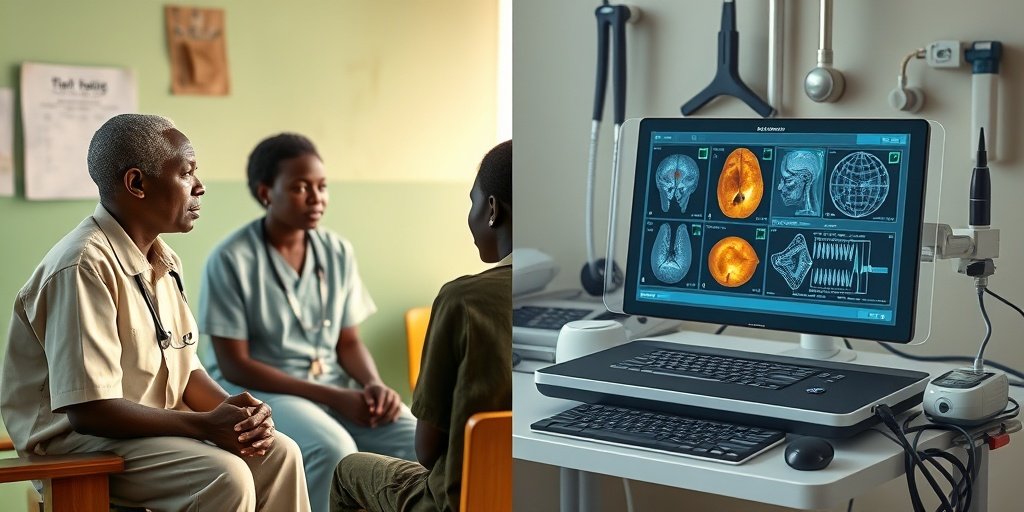⚡ Quick Summary
A recent study evaluated the use of POE (Q-Exp-Claude-3.5-2kk), a multimodal large language model, to enhance diagnostic accuracy in otolaryngology among general practitioners in rural Kenya. The findings revealed a 79.4% concordance with specialist diagnoses and a remarkable 96.8% alignment in management recommendations, highlighting the potential of AI in addressing healthcare challenges in low-resource settings.
🔍 Key Details
- 📊 Study Population: 63 consecutive patients in rural Kenya
- 🧩 Evaluation Method: Comparison between otolaryngologist and primary care practitioner (PCP) assessments
- ⚙️ Technology Used: POE (Q-Exp-Claude-3.5-2kk)
- 🏆 Diagnostic Accuracy: POE: 79.4%, PCPs: 50.8% (P = .001)
🔑 Key Takeaways
- 🤖 AI Integration: POE demonstrated significant potential as a clinical decision support tool.
- 📈 Diagnostic Concordance: 79.4% agreement with specialist findings.
- 💡 Management Recommendations: 96.8% alignment with otolaryngologist advice.
- 🔍 Differential Diagnoses: 73.0% deemed plausible and correct.
- 📸 Image Analysis: POE identified primary and potential diagnoses accurately in 85.7% of cases.
- 🌍 Resource-Limited Settings: Highlights the role of AI in enhancing healthcare delivery in low-income countries.

📚 Background
In Sub-Saharan Africa, healthcare delivery is often hampered by a shortage of specialists, particularly in rural areas. This gap in expertise can lead to misdiagnoses and inadequate patient care. The integration of artificial intelligence into primary care practices presents a promising solution to enhance diagnostic capabilities and improve patient outcomes in these underserved regions.
🗒️ Study
The study was conducted in rural Kenya, where 63 patients were evaluated by both an otolaryngologist and a primary care practitioner. Clinical data and micro-otoscopic images were submitted to the POE interface, allowing for a comprehensive assessment of the model’s diagnostic accuracy and clinical utility in otolaryngology.
📈 Results
The results indicated that POE achieved a 79.4% concordance with the diagnoses made by otolaryngologists, significantly outperforming PCPs, who had a diagnostic accuracy of only 50.8% (P = .001). Furthermore, POE correctly identified conditions in cases where PCPs failed to establish a diagnosis 61.3% of the time, showcasing its potential as a reliable diagnostic tool.
🌍 Impact and Implications
The implications of this study are profound. By leveraging AI technologies like POE, healthcare systems in low- and middle-income countries can enhance the diagnostic capabilities of general practitioners, ultimately leading to improved patient care. This approach not only addresses the shortage of specialists but also empowers primary care providers with advanced tools to make informed clinical decisions.
🔮 Conclusion
This study underscores the transformative potential of artificial intelligence in healthcare, particularly in resource-limited settings. The promising results from POE suggest that AI can significantly enhance diagnostic accuracy and clinical decision-making among general practitioners. Continued research and implementation of such technologies could pave the way for a more equitable healthcare landscape in Sub-Saharan Africa and beyond.
💬 Your comments
What are your thoughts on the integration of AI in healthcare, especially in underserved regions? We would love to hear your insights! 💬 Share your comments below or connect with us on social media:
Expanding the Capacity of General Practitioners in Sub-Saharan Africa With Artificial Intelligence.
Abstract
Low- and middle-income countries face substantial healthcare delivery challenges due to specialist shortages. This study assessed POE (Q-Exp-Claude-3.5-2kk), a multimodal large language model, for diagnostic accuracy and clinical utility in otolaryngology across 63 consecutive patients in rural Kenya. Patients underwent evaluation by both an otolaryngologist and primary care practitioner (PCP), with clinical data and micro-otoscopic images submitted to POE’s interface. POE’s primary diagnoses demonstrated 79.4% concordance with otolaryngologist findings, while management recommendations aligned in 96.8% of cases. Differential diagnoses were judged plausible and correct in 73.0% of cases. POE demonstrated significantly superior diagnostic accuracy compared to PCPs (79.4% vs 50.8%, P = .001). Among cases where PCPs failed to establish a diagnosis, POE correctly identified 61.3%. With examination images, POE accurately identified conditions as primary (50.0%) or potential (35.7%) diagnoses, demonstrating value as a clinical decision support tool in resource-limited settings.
Author: [‘Lechien JR’]
Journal: Otolaryngol Head Neck Surg
Citation: Lechien JR. Expanding the Capacity of General Practitioners in Sub-Saharan Africa With Artificial Intelligence. Expanding the Capacity of General Practitioners in Sub-Saharan Africa With Artificial Intelligence. 2025; (unknown volume):(unknown pages). doi: 10.1002/ohn.1335